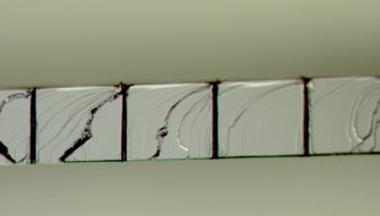
| Home | About Us | Contribute | Bookstore | Advertising | Subscribe for Free NOW! |
| News Archive | Features | Events | Recruitment | Directory |
News
2 July 2010
NRL develops new laser-machining techniques for radiation detectors
Scientists at the US Naval Research Laboratory (NRL) in Washington DC have developed new techniques for laser-micromachining a variety of semiconductors, including silicon (Si), cadmium telluride (CdTe) and indium phosphide (InP), to fabricate radiation detectors. “The new detectors will enable the next generation of space-based high-energy radiation astronomical research and might also be used for homeland security applications,” says Dr Bernard Phlips, who heads the team.

Picture: Optical micrograph (cross-section) of 10 micron -wide laser-machined holes in 450 micron-thick InP substrate.
The Radiation Detection Section of NRL’s Space Science Division is developing novel radiation detectors based on hole- or trench-arrays in semiconductors, i.e. three-dimensional (3D) detectors. A widely spaced hole-array is desirable since it allows lateral depletion and charge collection. This decreases the device thickness and depletion voltage and consequently reduces material quality requirements and cost. The radiation detectors to be produced with these new techniques will have a smaller size and substantially lower weight and power consumption than current state-of-the-art devices, NRL says.
The NRL team says that its reproducible new fabrication methodology is the critical process step for 3D hole-array detector development. The resulting laser-micromachined holes have a much higher aspect ratio than holes achieved with standard fabrication techniques (e.g. up to 100:1 in silicon, compared with a maximum of only 40:1 traditionally).
The laser-micromachining hole-array work is being performed at NRL’s Institute for Nanoscience (NSI), which has just installed a new E-Series micro-machining system from Oxford Laser that is making this work possible. Dr Marc Christophersen of NRL’s High-Energy Space Environment Branch, who developed the novel laser-machining techniques, is the NSI custodian for the micro-machining system. In addition to performing his own research on the system, he is responsible for user training, tool maintenance, and the initial tool start-up.
![]() Search: CdTe InP Radiation detectors
Search: CdTe InP Radiation detectors
Visit: www.nrl.navy.mil